Why do we Mulch?
Much ado about Mulch
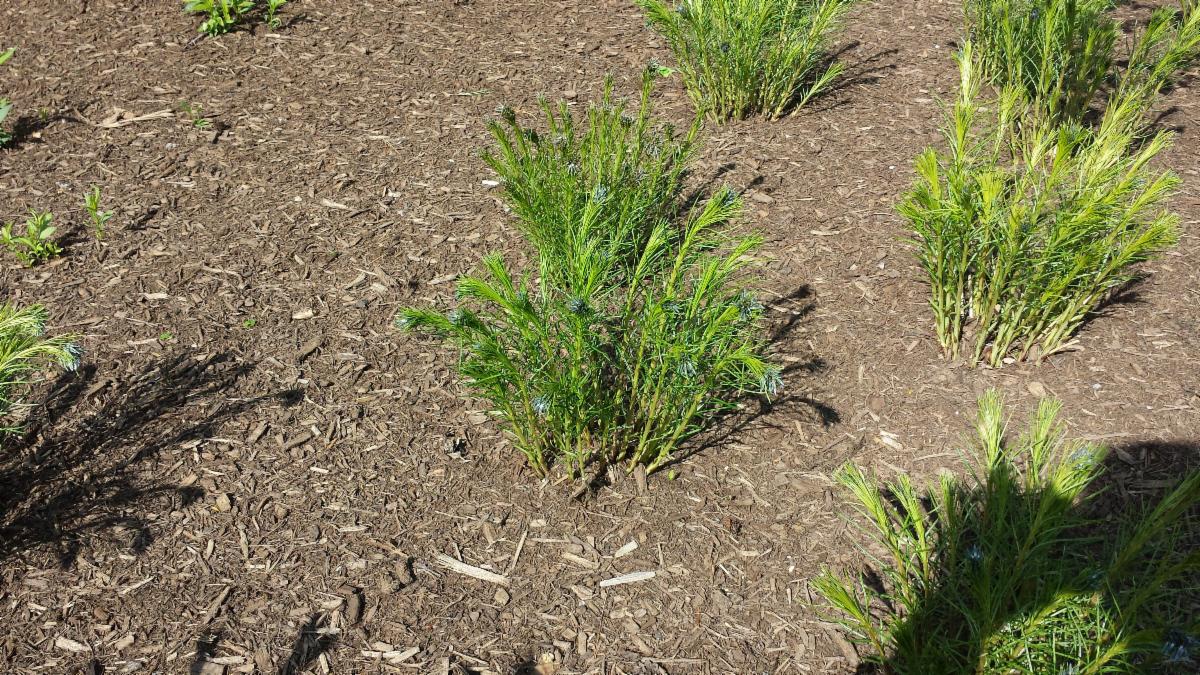
Arkansas Amsonia (Amsonia hubrichtii) in a sea of mulch....
Over the past 20 years, 'dead' mulch (that is to say, mulch made of wood chips, shredded bark, etc.) has become something of a landscape phenomenon. Tiny islands of plants are often isolated in large, sweeping beds of dyed black, red, or brown mulch. The mulch itself is (oddly) considered a landscape feature. Today this is taken as a matter of course, partly because of how common commercial gardens of annuals have become, where, as summer turns to autumn, the marigolds are simply thrown in the garbage or compost and replaced with mums, etc. The truth is that gardens were not always designed this way! If you think about it, you might find it very strange that the visual appeal of so many gardens (by definition a place where plants grow) is considered dependent on a non-plant element, especially since that non-plant element is basically dyed wood detritus spread over the ground. Of course, this isn't to say that mulch doesn't have its uses. Properly used, mulch prevents soil erosion, suppresses weeds, minimizes moisture and temperature fluctuations, and slowly adds organic matter to the soil of the garden. But groundcover plants (aka, living mulch) provide the exact same advantages, with the added benefit of beauty and usefulness to wildlife (including birds, butterflies, and beneficial insects!). In days gone by, 'dead' mulch was really only used when a garden was starting out, to give your newly-established plants a leg up as they were beginning to mature in place. It was, and still should be, an indicator of a new or immature garden. The heavy, repeated mulching that's considered standard practice in gardens of annuals (which are, by their nature, perpetually immature gardens) really doesn't translate well to gardens of native perennial plants, for several reasons...
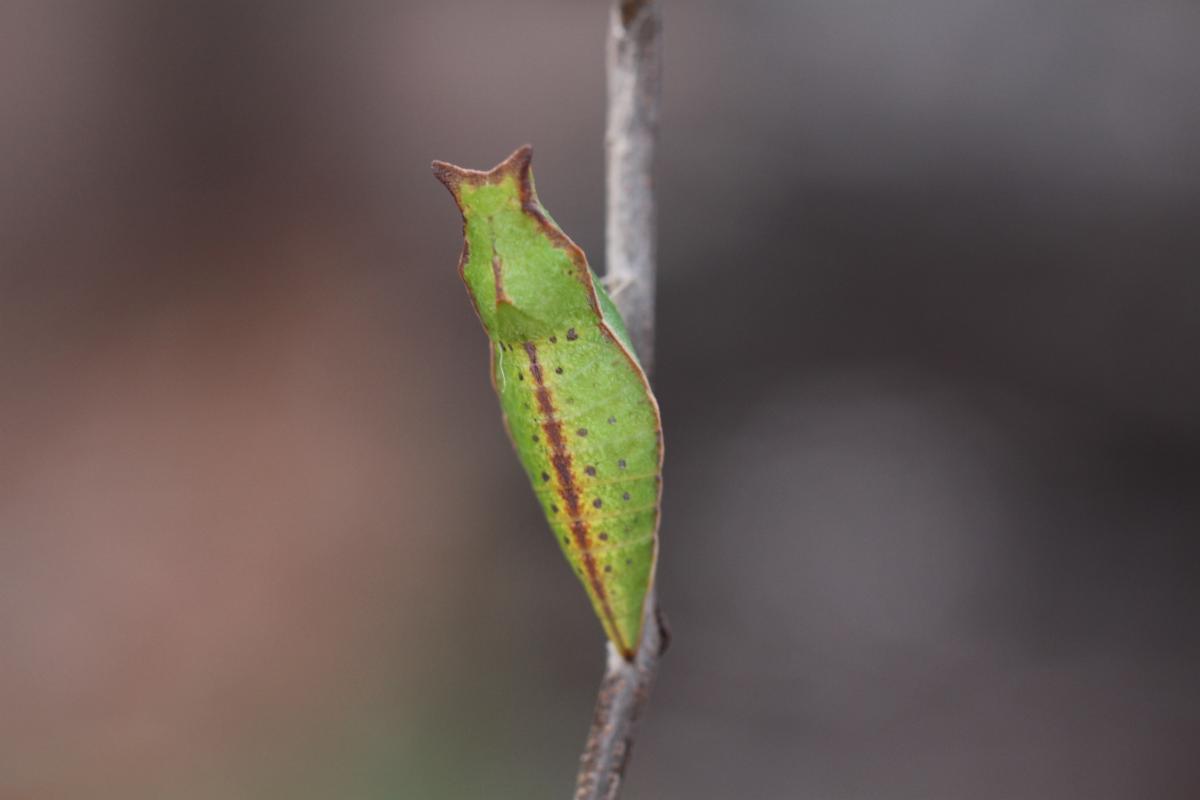
Spicebush swallowtail (Papilio troilus) chrysalis--the overwintering form of this butterfly patiently awaiting spring.
Things you might not know about Wood Chip Mulch...
There's a persistent and problematic myth that we must rake away and remove every iota of leaves and living material from our gardens twice a year, and replace it all with wood chip mulch (that we buy from companies that are very happy to take our money on such a cyclical basis). We've discussed this before, but sadly, taking away your fallen leaves and replacing them with purchased ('imported') mulch largely just results in overwintering butterflies (some overwinter as adults, others as larvae or chrysalis/pupae, or even eggs), queen bumble bees, and all manner of wildlife that live in leaf duff being sent to the landfill, while providing no particular benefit to the garden itself.
The fact is, unlike leaf duff or groundcover plants, (which are useful to beneficial wildlife,) very little lives on/in wood chip mulch except some fungi (such as Artillery Fungus and the aptly named Dog Vomit Fungus) and slugs. Artillary Fungus, in particular, is worth noting: a wood chip mulch-loving fungus that shoots sticky black spores up to thirty feet where they'll permanently adhere to things like cars and house siding (what's not to like?). No one wants that in their landscape. On top of everything else, wood chips aren't actually even an ideal source for adding organic matter to a garden. Many landfills no longer accept construction debris, so a significant portion of castoff construction wood is shredded, dyed a uniform color, and...sold, to be spread on gardens. Commercial bulk wood chips are quite frequently made of old pallets and wood scraps, which are then dyed to make them look 'attractive'. This is laudable recycling, but rather misleading, and potentially problematic (for example, was treated wood used to make this mulch? Who knows?). There are of course other options, including "arborist chips." You can get these from tree management companies, often for free, and they're just the shredded remains of recently-downed trees. I have used these myself, but the truth is that you can't be sure what you're getting: Black Walnut (Juglans nigra) trees are extremely common around us, but are allelopathic, meaning they contain a chemical (juglone, in this case) that discourages the growth of many plants. And yes: shredded poison ivy, if it was growing up the tree that became your new arborist chips, can certainly give you a terrifically itchy rash when you are done spreading your 'free' mulch (I've been there and done that, too). What's more, there's no guarantee that you're not importing leaf diseases, fungus spores, etc. with your newly-shredded mulch. Another option is licorice root mulch, which markets itself as being resistant to artillery fungus and so forth, but also smells quite pungent when spread, and pine bark mulch, which you can at least identify to genus, but at the end of the day...why? We all have leaves in our garden that provide actual free mulch: left approximately in place, these leaves will nourish and support our gardens and wildlife. Dead 'imported' mulch should not forever be the base layer of a mature garden, especially if your goal is to have a living, sustainable garden that supports your local butterflies, bees, birds, etc. Additionally, there's a far more attractive and sustainable option that self-perpetuates, and will serve your local environment far better than seas of wood chips (however deluxe they may be) ever could.
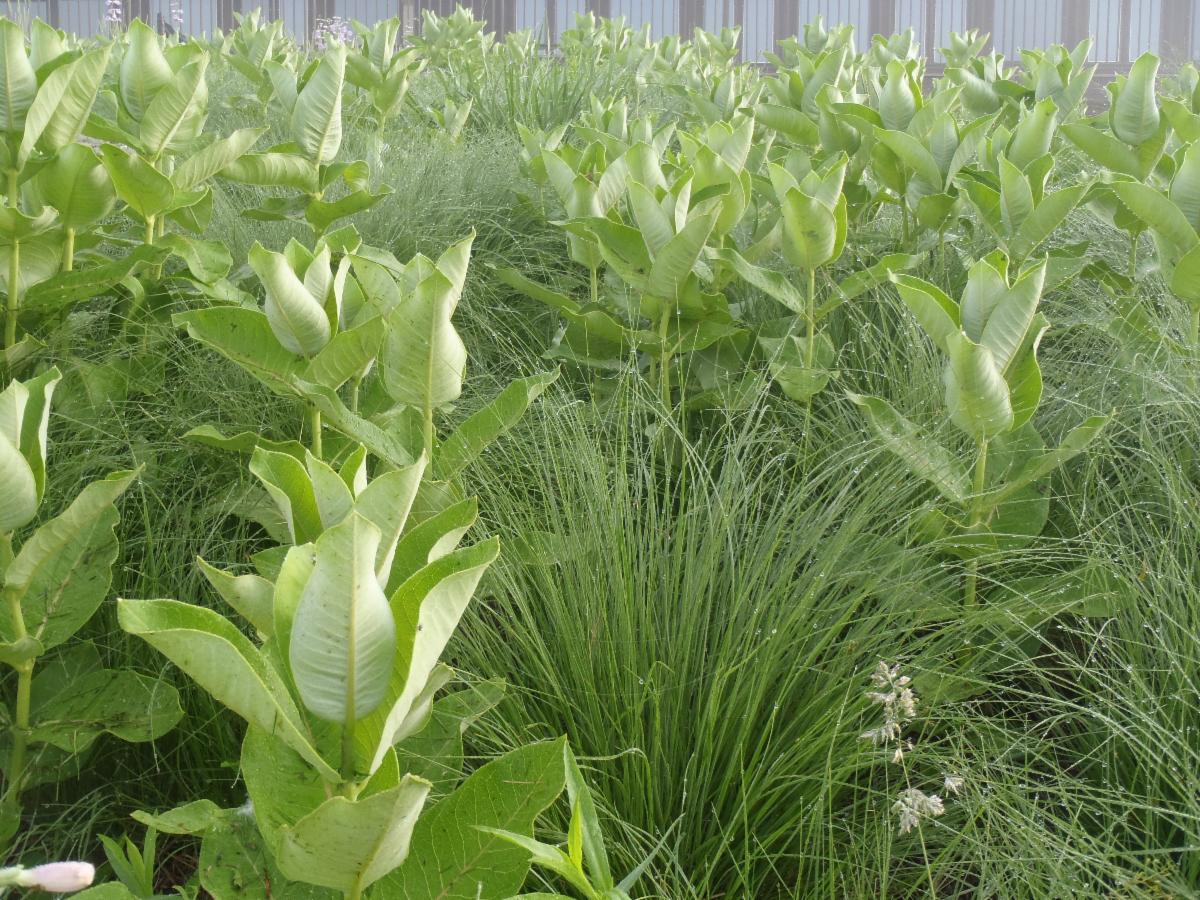
Common Milkweed (Asclepias syriaca) surrounded by other native plant 'friends'
Introducing Groundcovers: Plants are Meant to Live in Communities
Native plants are immensely beautiful, but most make for poor 'island' plants set in isolation among a vast expanse of mulch. Because...that's not how plants grow! In our fields, forests, prairies, sand dunes, and mountaintops, plants live in communities: many plants actually shed their lower leaves, not because there's anything wrong, but because they expect to have neighbors shorter than themselves growing underneath them taking up that space. Living in a community keeps tall plants supported and protected, provides wildlife habitat, and visually adds beautiful texture. Groundcover plants, meanwhile, provide all the benefits of mulch: they insulate the soil against extreme temperatures, help with moisture retention, prevent weeds, and add organic matter to the soil over time. Unlike wood chip mulch, however, they have additional ecological benefits. Depending on the species, they can support pollinators, provide wildlife habitat, act as host plants for beneficial insects, beautify the landscape, actively prevent soil erosion by stabilizing the soil with their roots, and self-perpetuate -- meaning that they're handily more sustainable than any other option. It turns out, the best mulch is the kind that you don't have to buy every dang year, or even necessarily spread by hand. Plant a groundcover appropriate for your garden conditions, and odds are, it'll spread itself. The truth is, a lot of short plants actually have remarkable ecological value, and will grow quite happily as a base layer for your garden. And your other plants will benefit from having more plants around them!
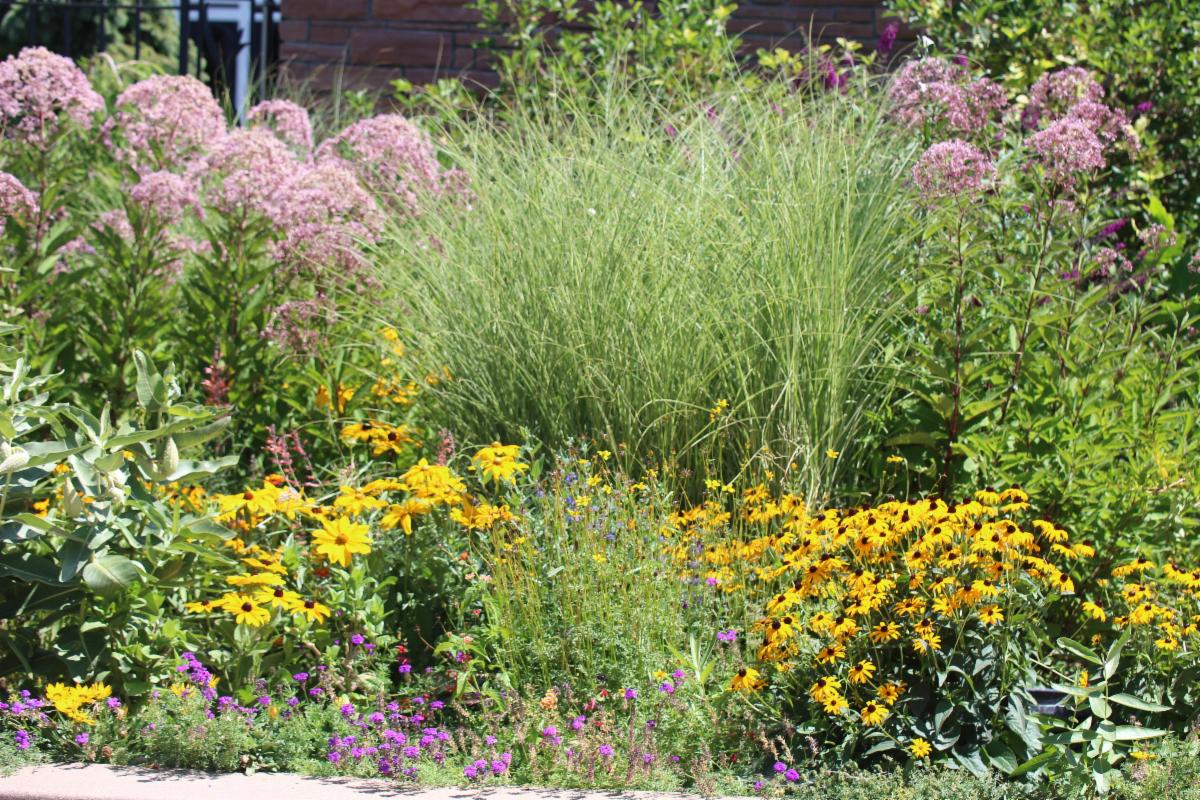
Eastern native plant showcase garden at the Denver Botanic Gardens - look at all the different height plants filling every space!
Alright, so what are these Groundcover Plants you speak of?
We'd be here all day if we tried to highlight all of them: the fact of the matter is, there is a groundcover for every garden condition (yes, including formal gardens). We've created a cheat sheet of great Native Groundcovers to browse for ideas, but we'll do a quick run through a few of them, just to give you the sense of the variety of options. Many people believe that the alternative to a sea of mulch is something that would get them scolded by most housing associations for looking 'weedy.' This is a misconception! Visit any botanical garden and you'll see many examples that give lie to that idea. And the best part is, it doesn't require the staff of a botanical garden to accomplish a very similar level of showiness. Here are a few examples:
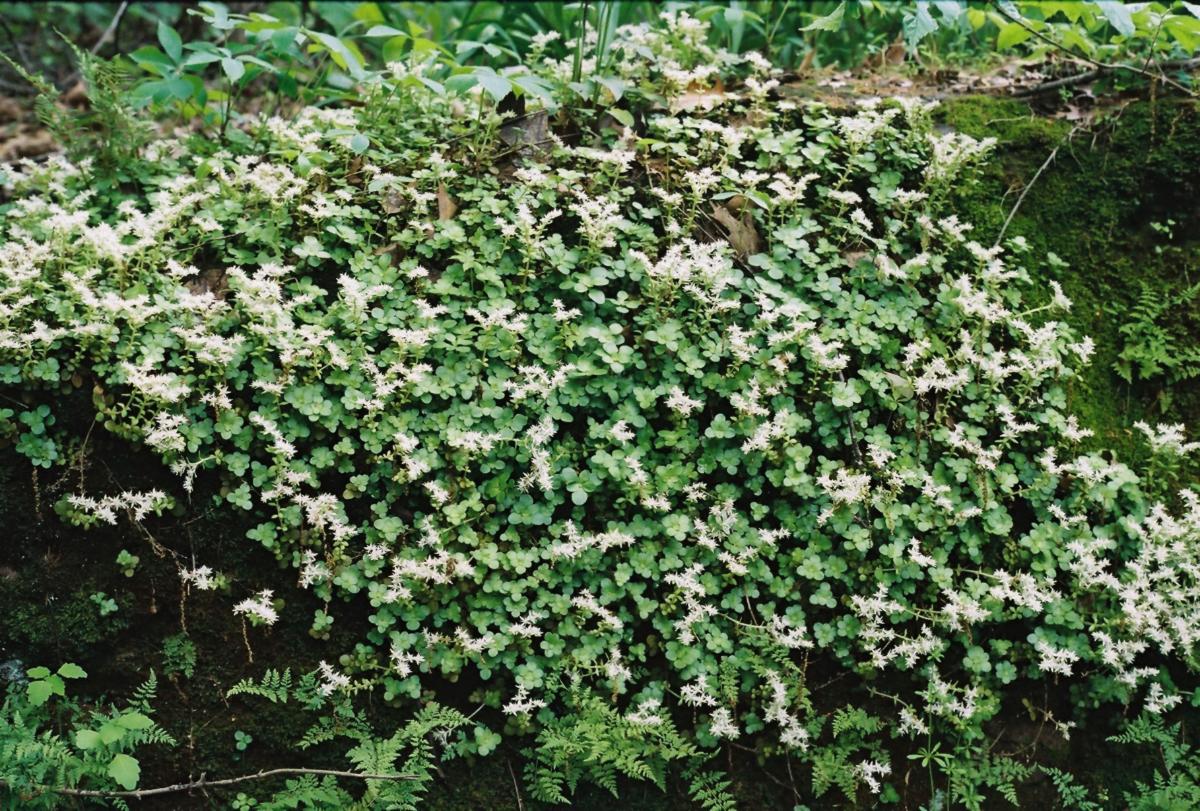
Wild Stonecrop (Sedum ternatum) is a true succulent, and remains very low to the ground even as it puts out showy white flowers in the spring. It prefers woodlands, but is tolerant of both moist and dry conditions. It's also an evergreen, and a host plant for the Variegated Fritillary (Euptoieta claudia) butterfly!

Dwarf Crested Iris (Iris cristata) is an adorable iris species that only gets to be about a foot tall. It's fairly flexible about where it grows, although it prefers a decent amount of light, and has gorgeous blooms in the spring.
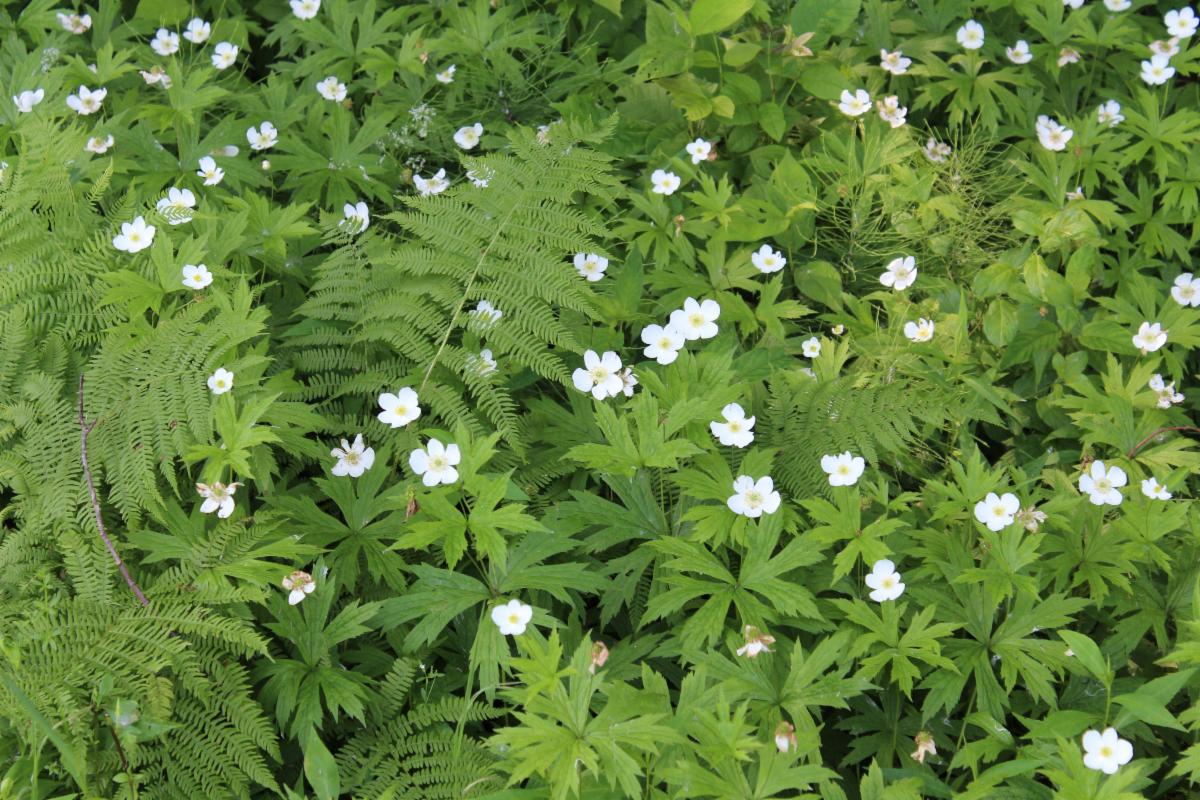
Canada Anemone (Anemone canadensis) is a gorgeous spring bloomer that spreads by rhizomes and likes average to slightly moist conditions and moderate levels of sunlight. It's really eye-catching when it's in flower, and its leaves are showy all season long.
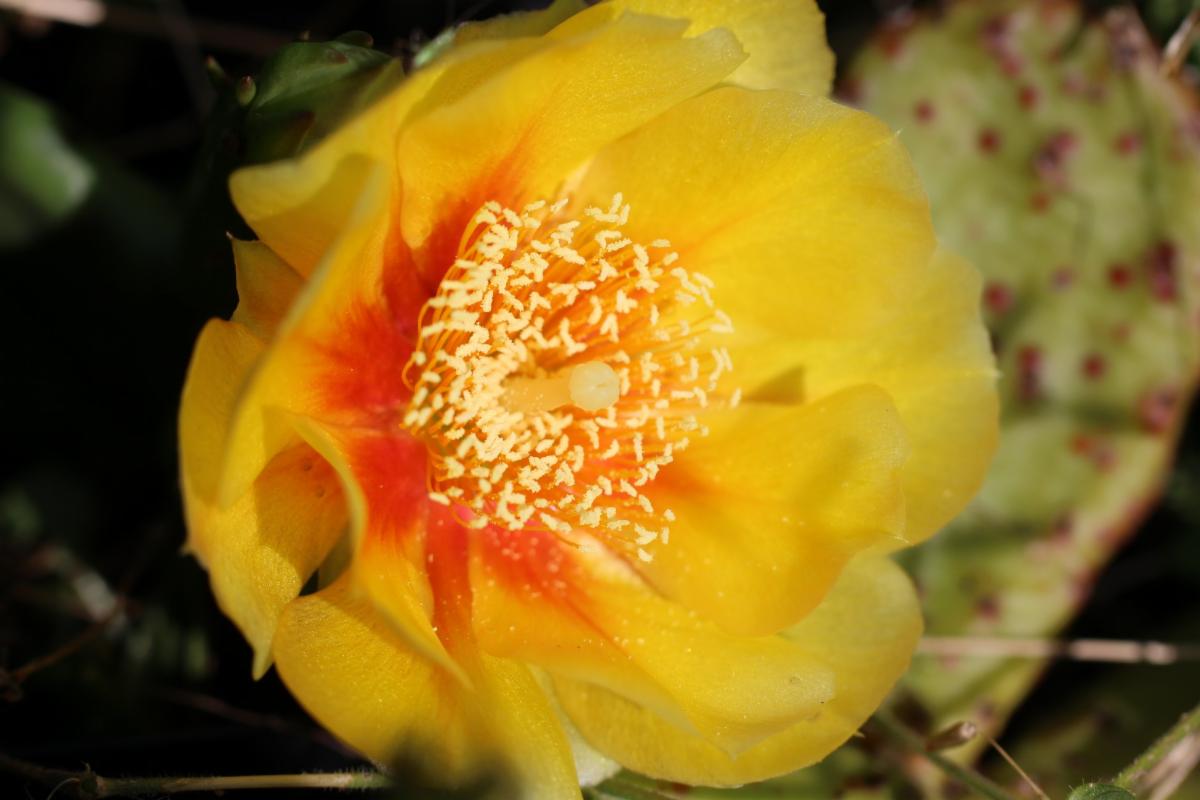
Prickly Pear Cactus (Opuntia humifusa) is an unconventional beauty that blooms in the summer and (unsurprisingly) is very resilient to drought. It's also remarkably tolerant of having plants grow over its head: definitely worth considering as a groundcover in certain gardens!
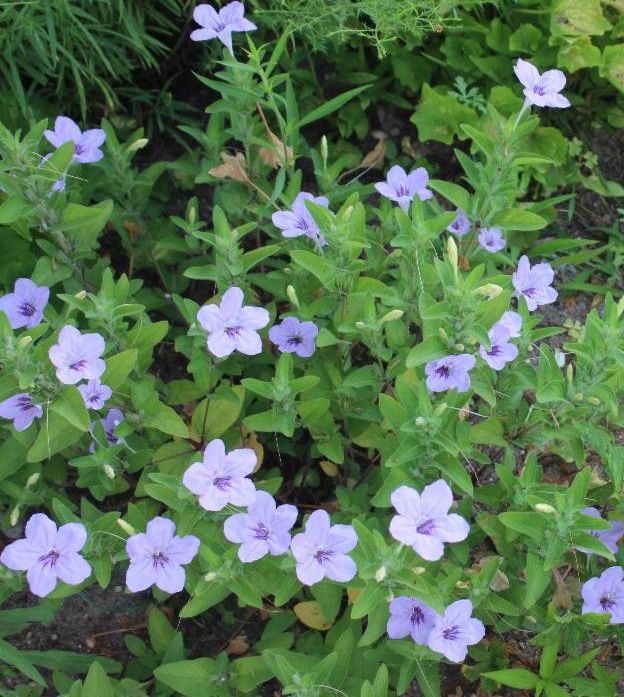
Wild Hairy Petunia (Ruellia humilis) has more to offer than just a bizarre name; it's a tenacious little plant that will absolutely bloom in the face of adversity, be that drought or getting run over by a lawnmower. It does just fine in dry and sunny conditions, and blooms throughout the summer.
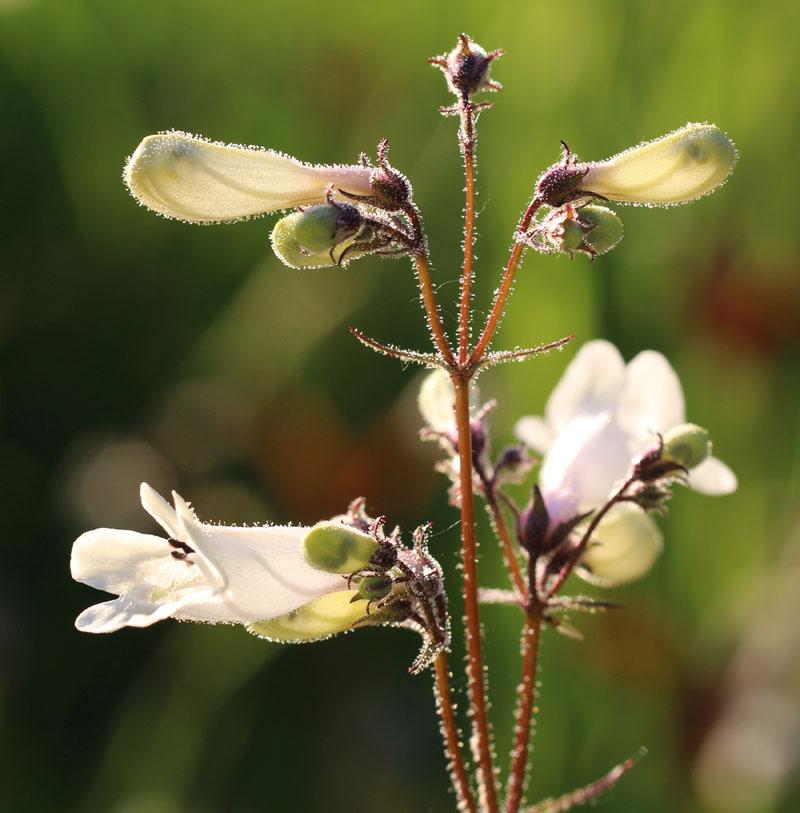
At first blush, 'Tall' White Beardtongue (Penstemon digitalis) might not seem like a groundcover species; after all, it can grow up to 4 feet tall. But it grows from an evergreen basal rosette of thick leaves that stay very low to the ground. The "tall" part of the plant is quite slender and won't block the view of other garden plants. Its stiff stems support white flowers in early summer that pollinators adore, which in turn develop into little bead-like seedheads. It likes sunny conditions, and will handle anything from a dry meadow to a rain garden just fine. It is also one of the most Deer Resistant plants we sell.
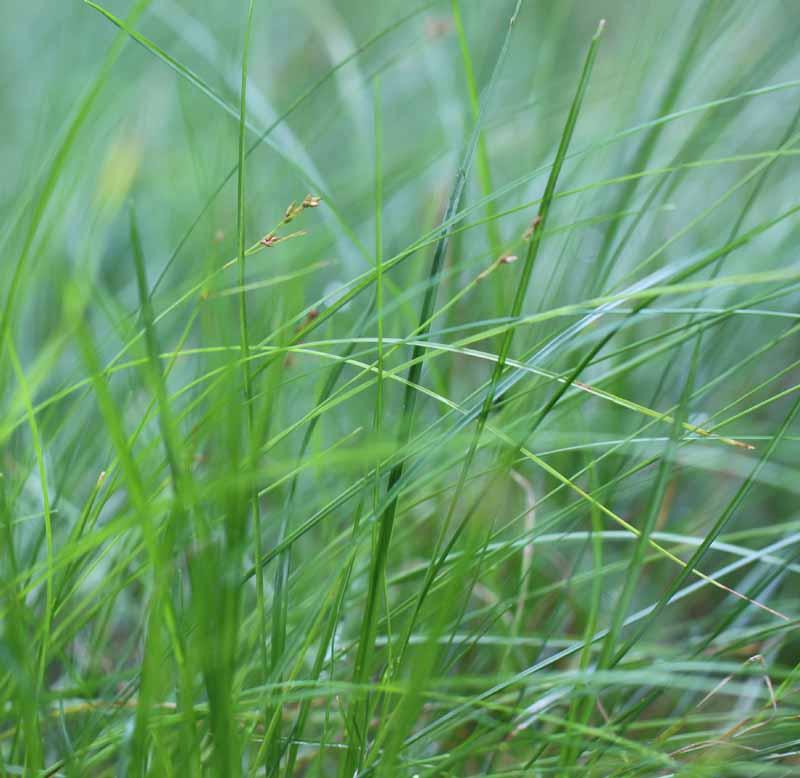
An elegant little hero of shady, dry conditions, Rosy Sedge (Carex rosea) will grow in places many plants won't, and it'll look classy while it does it: also, it's an evergreen!
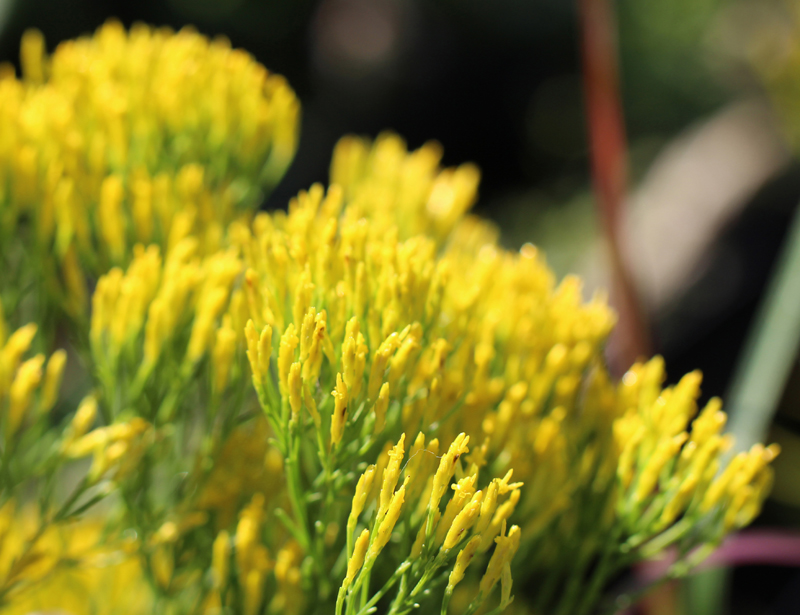
Nuttall's Rayless Goldenrod (Biglowia nuttallii) is a rare and tiny fine-leaved plant that thrives in rock gardens and exposed, adverse conditions. It blooms in September and October.
So Don't Neglect The Base Layer!
A good garden should have layers to provide habitat for birds and beneficial insects (to say nothing of the texture and beauty layers can add!), and the bottom layer is nearly always the most neglected. There's no need for this to be the case! With a bit of research, you can find a beneficial native groundcover for your garden no matter where you live, or what style of garden you have. You can add butterfly host plants like violets (thereby encouraging more butterflies!), fruit-bearing species like wild strawberry (thereby encouraging more birds!), little plants with gorgeous flowers, or simply species with wonderful foliage, much like adding greenery to a bouquet to accentuate the beauty of what's already there. Have fun with it, and don't be afraid to experiment! There are so many ways to add beauty to your garden, and support your local wildlife as you do it.
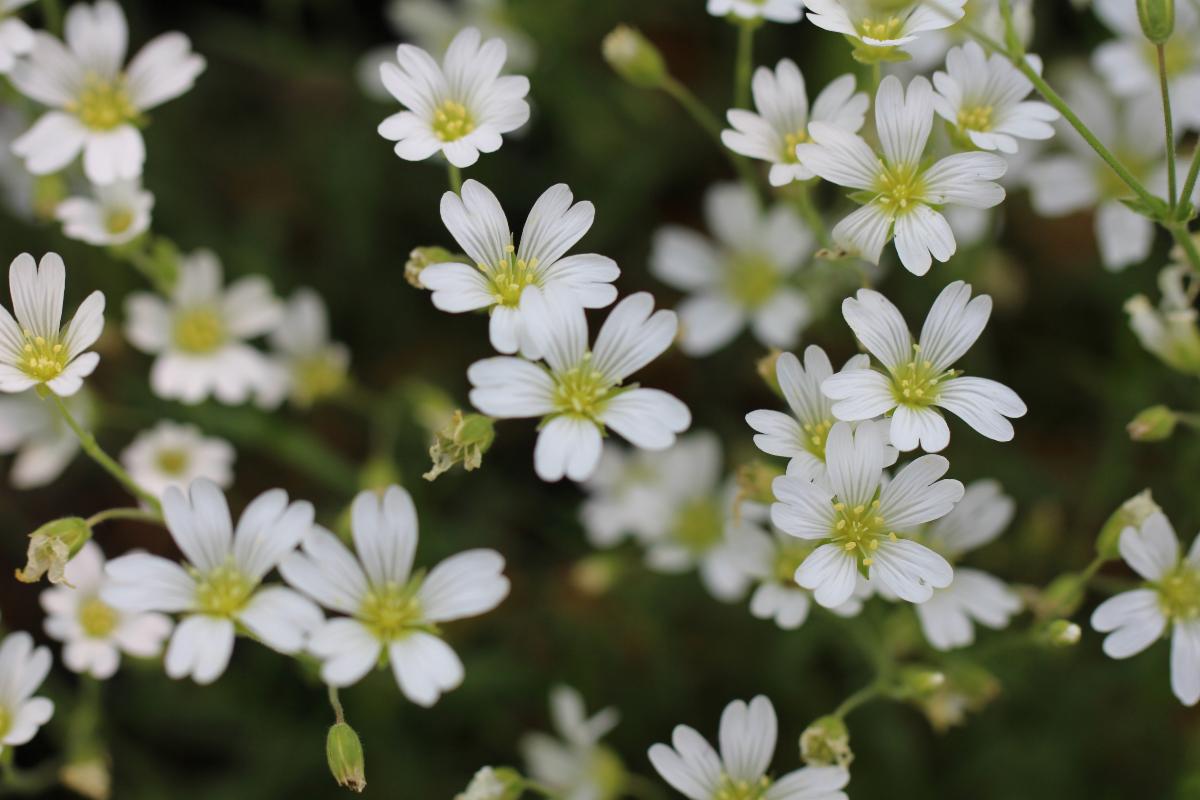
Starry Cerastium (Cerastium arvense)

Randi V.W. Eckel, PhD
